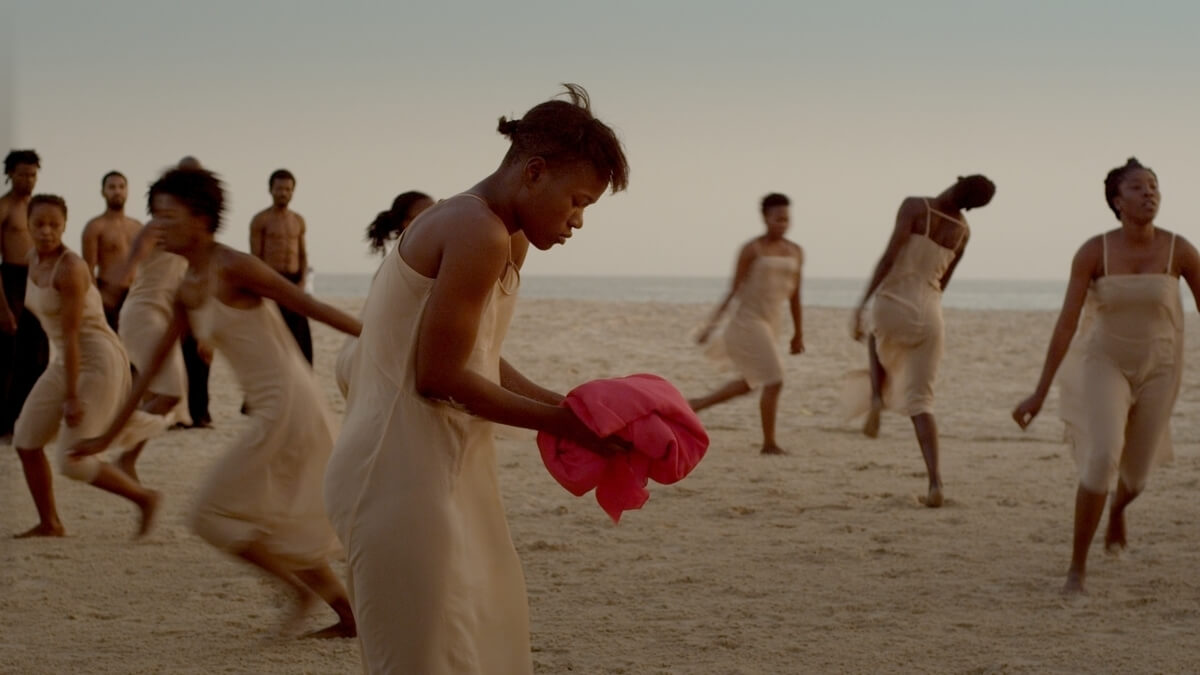
In the annals of contemporary dance, German choreographer Pina Bausch (1940-2009) is among the exalted few. Her name is always intoned with the deepest of reverence. The visionary works that she created for her company, Tanztheater Wuppertal Pina Bausch, are still touring the world, enchanting and provoking audiences old and new, with her trademark exhilarating fusion of movement, sound and visual elements.
Had the global pandemic not happened, five Canadian cities would have been gifted with a performance by Tanztheater Wuppertal. This past fall, Montreal, Ottawa, Toronto, Calgary and Vancouver would have experienced one of Bausch’s most iconic works, Nelken (1982). Alas, that was not to be.
Happily, we five are still getting a Bausch fix, thanks to the initiative of Danse Danse, Montreal’s premiere presenter of international dance. With the collaboration of the group’s co-presenters — National Arts Centre (Ottawa), Canadian Stage and Harbourfront Centre (Toronto), Springboard Performance (Calgary) and Dance House (Vancouver) — Danse Danse has put together a Bausch package built around the choreographer’s treasured The Rite of Spring (1975) for ticketed, online viewing. It may not be Nelken, but it’s a terrific substitute nonetheless.

The Online Presentation
The centrepiece of the program is a performance of The Rite of Spring by 38 dancers from 14 African countries. The dance itself runs just 40 minutes, so Danse Danse has plumped up the offering with some homegrown goodies.
To begin, Danse Danse has put together a pre-show mini-doc, Les multiples visages du Sacre du printemps, hosted by dance history teacher Valérie Lessard from Ecole de danse contemporaine de Montréal. It is said that there are over 1,000 different dance versions set to Stravinsky’s seminal score, and this short documentary features fast clips of myriad productions, interspersed with commentary from choreographers, including a delightful appearance by beloved dance iconoclast, Marie Chouinard.
This is followed by the film, Dancing at Dusk — A moment with Pina Bausch’s The Rite of Spring, which itself, is followed by Pina Bausch The Rite of Spring — Rehearsals at Ecole des Sables. The former is the actual performance. In the latter, Salomon Bausch, Pina’s son, and the head of the Pina Bausch Foundation, Jorge Puerta Armenta and Josephine Ann Endicott, former Bausch dancers who set the work, and several of the African dancers, talk to the history of the project, and the rigours of the Rite itself.
Finally, we are treated to a post-show interview conducted by Lessard, with Armenta and Germaine Acogny, artistic director of École des Sables, who helped spearhead the project.
All in all, I found these additions most worthwhile, because it gave context to the performance.
A Few Words About the Original The Rite of Spring (and a little bit about Bausch)
There are several stories afloat about where the idea for The Rite of Spring came from, but all agree that composer Igor Stravinsky had a fleeting vision. What he saw in his mind’s eye was a series of ancient rituals celebrating the coming of spring, and a young girl, the Chosen One, being the sacrificial victim who dances herself to death to appease the gods. In fact, the subtitle of the ballet was Pictures of Pagan Russia in Two Parts, which Stravinsky called The Adoration of the Earth and The Sacrifice.
In 1913, Serge Diaghelev’s Ballets Russes presented the premiere of Stravinsky’s score with choreography by acclaimed dancer Vaslav Nijinsky at Théâtre des Champs-Elysées in Paris. The evening has gone down in dance history as one of the most infamous performances ever. The dissonance and modernisms of the score, coupled with the earthy physicality of the choreography were too much for the fashionable crowd, the traditionalists, to take. When they started to shout at the stage, the bohemian crowd, the avant-garde, began shouting back at them, drowning out the orchestra, with the audience as a whole finally descending into chaos. Nonetheless, the dance continued without missing a beat.
Over time, Stravinsky’s score has become one of the most beloved concert works in the classical repertoire. It has also long remained a lure to choreographers. The brilliance of Bausch’s Rite of Spring, which debuted in 1975, is how she captures the variations in the music. Every shift, every nuance, is translated into specific dance patterns which renders the score into visible motion. She particularly captures Stravinsky’s driving rhythms with frenzied movement that at times is absolutely terrifying.
All of Bausch’s works are about human relationships, and she sees Rite as a battle of the sexes. The men dominate, the women mostly cower, and this patriarchal oppression is made all the more horrifying with the death of the Chosen One, and the harrowing violence of her final solo. Of course, this description is just the tip of the iceberg as to what is going on in the piece. As a side note, Bausch programmed The Rite of Spring every year, and rehearsed her dancers into exhaustion, demanding more and more intensity from them with each iteration.
Background to the African Rite of Spring
As well as touring Bausch’s works around the world, company dancers, both former and present, are kept busy setting the choreographer’s pieces on various companies. It was Armenta who came up with the idea of teaching the work to individual dancers, brought together for just this one project, which somehow was settled in Africa as the place of experimentation.
Enter Acogny, whom many consider the Mother of African Contemporary Dance. Her school, Ecole des Sables, situated in Toubab Dialaw, just an hour away from Senegal’s capital Dakar, accepts French, English and Portuguese-speaking students for dance training. Acogny, also a noted dancer, was introduced to Salomon Bausch when she was performing in Brussels, and the project was launched.
At the time of the global lockdown, the 38 dancers had been rehearsing for a month and a half, with just ten days left before the Dakar opening, which would be followed by a tour to Wuppertal and London’s Sadler’s Wells Theatre. In fact, on March 14, the company had just had its first run-through of the complete work that morning, when they were given the bad news that the project had to be shut down.
As it happens, Salomon Bausch had just arrived in Senegal with the costumes and a shipping container filled with peat moss. For those familiar with Bausch’s Rite of Spring, you will know that the piece is performed on a stage awash in dirt. Salomon came up with the inspired idea to film what would be only the second run-through of Rite on the nearby beach, with sand substituted for peat. No matter how raw, at least there would be a record of what had been accomplished thus far. It was helpful that a Sadler’s Wells film crew, under director Florian Heinzen-Ziob, was on hand documenting the progress of the African Rite. With everyone in agreement to film what was this final rehearsal, the performance took place at dusk.
As for the dance itself, a part of the beach was raked off to represent the width and length of the stage. There was something totally beautiful about the muted colours of dusk, and the expanse of sky and sand, with the sea in the distance, and the wind rippling through the diaphanous slips on the women, and the full pants on the men.
It is interesting to hear Armenta’s thinking that they were ten days short of a performance. He regards the last ten days as the most important, as the dancers live with the work and embed it into their bodies and hearts and minds. Nonetheless, the performance is a triumph, and even Armenta has come around to that fact. Those dancers feel Bausch’s Rite in every bone, sinew and fibre of their being. The dance is also beautifully photographed. For those who like to know such things, Bausch chose Pierre Boulez’s recording of The Rite of Spring with the Cleveland Orchestra for her soundtrack, and that version has become canon.
Final Words
For one thing, I always like to learn new things, and I did in this presentation, cleverly put together by Danse Danse. The commentary in both the rehearsal film, and the zoom interview, is a treasure trove of information about being inside Bausch’s The Rite of Spring, which is one of my all-time favourite works.
But at the heart of the piece, are the magnificent dancers who pulled off a minor miracle in what was just a second run-through of this iconic work. Their rendition is poetic, visceral and unsettling, and Bausch would have loved it.
DANCING AT DUSK: A moment with Pina Bausch’s The Rite of Spring is available for rent until Oct. 28, for $15, on the websites of both Canadian Stage and Harbourfront (Toronto), Danse Danse (Montreal), National Arts Centre (Ottawa), Springboard Performance (Calgary) and Dance House (Vancouver). Details
#LUDWIGVAN
Get the daily arts news straight to your inbox.
Sign up for the Ludwig van Daily — classical music and opera in five minutes or less HERE.
- INTERVIEW | Actor Diego Matamoros Takes On Icon Walt Disney In Soulpepper Production Of Hnath Play - April 16, 2024
- SCRUTINY | Opera In Concert Shine A Light On Verdi’s Seldom Heard La Battaglia Di Legnano - April 9, 2024
- SCRUTINY | Lepage & Côté’s Hamlet Dazzles With Dance And Stagecraft Without Saying Anything New - April 5, 2024



